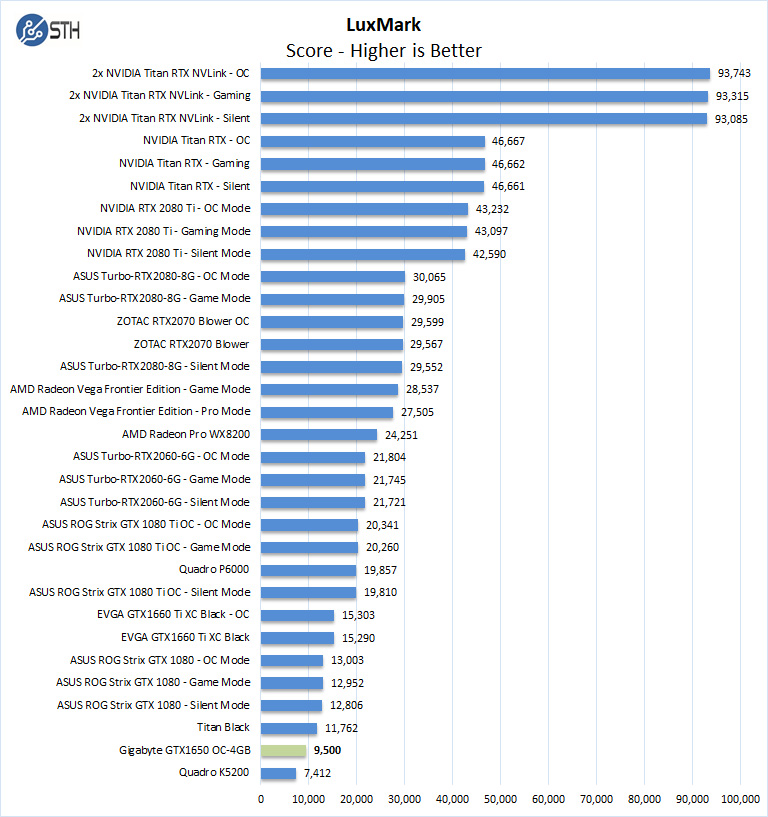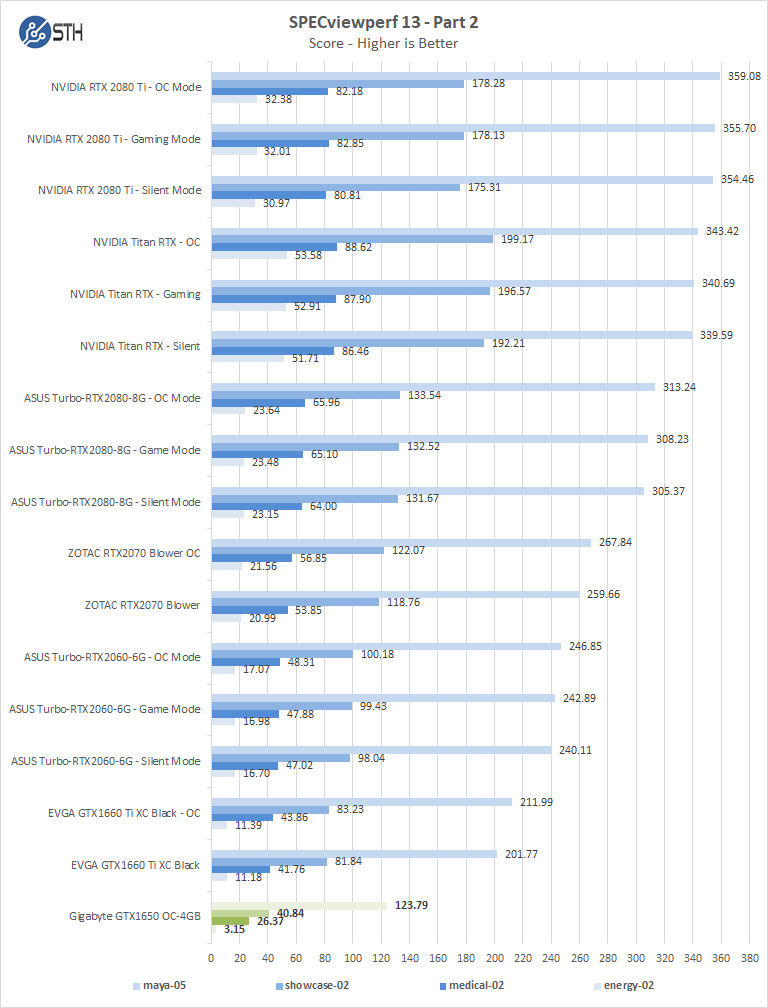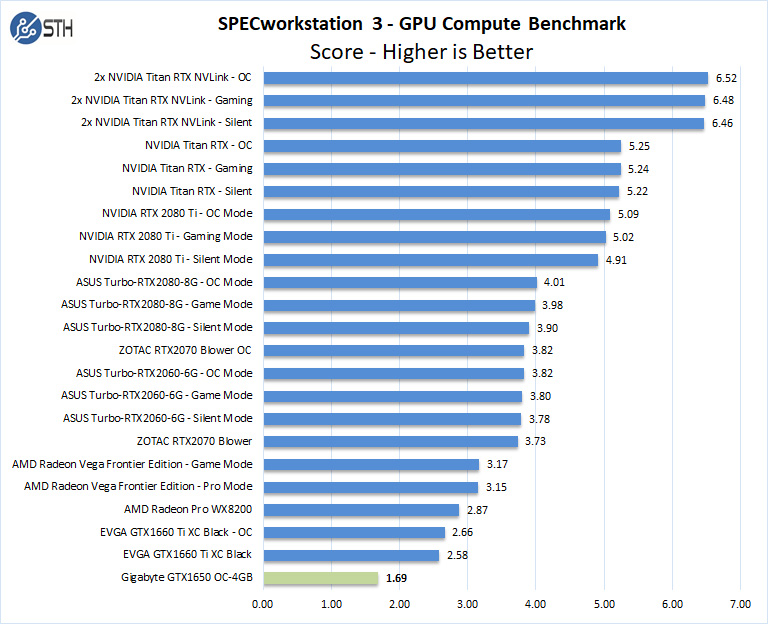Gigabyte GeForce GTX 1650 Compute Related Benchmarks
We are going to run the Gigabyte GeForce GTX 1650 OC through some benchmarks to see if the removal of RTX features and some compute capacity hurts the card significantly. On the other hand, it carries a lower price than the lowest-end “RTX” card we have reviewed, the ASUS Turbo-RTX2060-6G. If it is close to the same compute performance, it may be a better value.
As we continue to keep our graphics card benchmarks updated we have added the AMD Radeon Vega Frontier Edition results to several charts. We have our GeForce GTX 1660 review coming, but this is getting published just before that review. In addition, we added a new benchmark called hashcat64 to test password cracking performance, another common application for GPUs.
Geekbench 4
Geekbench 4 measures the compute performance of your GPU using image processing to computer vision to number crunching.

Our first compute benchmark we see the Gigabyte GeForce GTX 1650 OC comes in below the older GTX 1080 series. As an entry-level GPU, the Gigabyte GeForce GTX 1650 OC places about where we would expect.
LuxMark
LuxMark is an OpenCL benchmark tool based on LuxRender.

Here we again see lower-level Gigabyte GTX 1650 OC results with the card at the bottom of our list which we expected for a GPU in this class. Again, this is the least expensive GPU on the chart by a large margin so we expect we will see results similar to this in the up and coming benchmarks.
AIDA64 GPGPU
These benchmarks are designed to measure GPGPU computing performance via different OpenCL workloads.
- Single-Precision FLOPS: Measures the classic MAD (Multiply-Addition) performance of the GPU, otherwise known as FLOPS (Floating-Point Operations Per Second), with single-precision (32-bit, “float”) floating-point data.
- Double-Precision FLOPS: Measures the classic MAD (Multiply-Addition) performance of the GPU, otherwise known as FLOPS (Floating-Point Operations Per Second), with double-precision (64-bit, “double”) floating-point data.

Here in the single precision results, we see performance just above the NVIDIA Quadro K5200 which was a higher power, higher cost card five years ago.
The next set of benchmarks from AIDA64 are:
- 24-bit Integer IOPS: Measures the classic MAD (Multiply-Addition) performance of the GPU, otherwise known as IOPS (Integer Operations Per Second), with 24-bit integer (“int24”) data. This particular data type defined in OpenCL on the basis that many GPUs are capable of executing int24 operations via their floating-point units.
- 32-bit Integer IOPS: Measures the classic MAD (Multiply-Addition) performance of the GPU, otherwise known as IOPS (Integer Operations Per Second), with 32-bit integer (“int”) data.
- 64-bit Integer IOPS: Measures the classic MAD (Multiply-Addition) performance of the GPU, otherwise known as IOPS (Integer Operations Per Second), with 64-bit integer (“long”) data. Most GPUs do not have dedicated execution resources for 64-bit integer operations, so instead, they emulate the 64-bit integer operations via existing 32-bit integer execution units.

As one may expect, the Gigabyte GeForce GTX 1650 OC was at the lower end. We were surprised to see it just barely faster than the GeForce GTX 1080.
hashcat64
hashcat64 is a password cracking benchmarks that can run an impressive number of different algorithms. We used the windows version and a simple command of hashcat64 -b. Out of these results we used five results to the chart. Users who are interested in hashcat can find the download here.

The NVIDIA GeForce GTX 1650 OC is not a strong contender for hashcat and ranks noticeably below the GTX 1660 Ti.
SPECviewperf 13
SPECviewperf 13 measures the 3D graphics performance of systems running under the OpenGL and Direct X application programming interfaces.


Again, the NVIDIA GeForce GTX 1650 is a lower-end and lower-cost part. If you want more performance, it simply costs more. Here, the energy-02 benchmark was lower than we would have expected given our other results. In that test, the NVIDIA GeForce GTX 1660 Ti offers more than 3x the performance.
SPECworkstation 3
SPECworkstation3 measures the 3D graphics performance of systems running under the OpenGL and DirectX application programming interfaces.

This type of chart is becoming fairly standard for this exercise.
Let us move on and start with our rendering-related benchmarks.




comptue is used twice on page 6.
Performance might seem on par with other nvidia models but if you compare this by price to lets say a RX570 or RX580, its very bad value for money.
You included too much worthless information and not enough practical information. We’re is the 1060 and 1070? Who gives a shit about how it stacks up against a Titan rtx x2? Get real.
I think this is one of NVidia’s most useless cards ever.
First the memory leaks, now the patent issue with Xperi Corp. It are hard times for mister “the more you buy, the more you save”. Linus Torvals will laugh his head off.
OVERALL SCORE 9.1?
Value 9.3?
Are you out of your mind?
How about comparison with cheaper and more powerful rx570?
I think people are being a little unfair here – or perhaps unrealistic – bearing in mind the target audience of the site is home severs, which may not have a PSU that supports extra power.
Yes, the price is high for the performance on an absolute scale. But that does not recognize that you simply *cannot get* a 75W PCIe-only powered card that matches it from AMD. No RX 580 or RX 570 here – no, you will be stuck with the RX 560 (or RX 460) and the same 4GB RAM, getting anywhere from two thirds to a half the performance, or maybe even less: https://www.anandtech.com/show/14270/the-nvidia-geforce-gtx-1650-review-feat-zotac
The WX8200, that meets the 1650 in some benchmarks, and does twice as well in others, uses *three* times the power – a TDP of 230W.
Absolutely, wait for Navi to see if it can do better. I hope it does, because I want to use a card with good open-source drivers. But if you can’t – if you need 75W, no more, now – this may be the best there is; and it’s priced accordingly.
This was clearly written by someone who doesn’t know anything about computer hardware or gpus.
We’ve been using these in many of our servers exactly for what you describe. We’re using them with Xeon D Supermicro boards powered off of the motherboard in 1U systems. It looks like someone here has linked and brought the gaming kids here. NVIDIA’s still where it’s at if you want inferencing at the edge. Anyone that thinks AMD’s in the game today against CUDA isn’t in the space. Maybe that’ll change, but NVIDIA’s easy and it works, AMD there’s always troubleshooting.
@Paul I can tell you it’s useful to us. We buy a spectrum of GPU’s for our customers. Having this info top to bottom is handy both for us and for our customers.
Good review. I’d like to see a blower style 1650 review since that’s the sweet spot in the market
Most of the comments here seem to have been made by those who own a giant rig and a powerful PSU — gamers. For those of us who prefer a system with a small physical footprint and low power consumption, while still being able to play at 1080p competently, this card is basically it for now until the fabled RX 3060 comes out. The comparison between this and the RX570 simply isn’t fair due to the huge discrepancy in power consumption. I do love AMD and support them when I can to create competition to Intel and NVIDIA, but it’s been a known fact that they compensate with lack of finesse with just raw and massive heat/power/energy consumption, which could costs end users hundreds if not thousands of dollars per year, and is horrible for the environment.
Hi, Thank you for providing such valuable information. In my opinion, the GeForce GTX 1650 is an excellent Graphics Card. It is in the best interests of everyone….